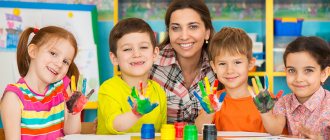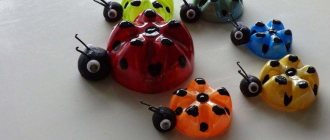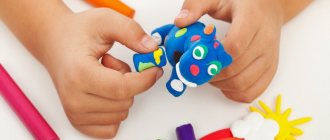Joint partnership between an adult and preschool children
Lyubov Dushebaeva
Joint partnership between an adult and preschool children
In connection with the introduction of the Federal State for preschool education, approaches to organizing activities in kindergarten . The leading type of activity is the joint activity of an adult and a child , in which the teacher becomes a partner .
The main features of joint activities of adults and children are highlighted - the presence of a partner position of an adult and a partner form of organization of activity , by which we mean such factors as cooperation between adults and children and the possibility of free movement and communication of children.
An essential feature of partner activity between an adult and children is its openness towards the free independent activity of preschoolers themselves . At the same time, adult partner activities are open to design in accordance with the interests of children.
Speaking about the partner position of the educator , we mean that he is an equal participant in the activity and, as such, is connected with others by mutual respect. between teachers and children . Respect is a necessary element in the community that the kindergarten group is. Educators set the example of mutual understanding, respect and care for each other that they expect from children.
partner position contributes to the child's development of activity, independence, the ability to make decisions, try to do something without fear that it will turn out wrong, evokes a desire to achieve, and promotes emotional comfort.
Positions of the teacher at different moments of joint activity .
The teacher invites children to engage in activities at ease :
• Let's do it today.
• Anyone who wants to, make yourself more comfortable.
• Anyone who wants to join.
Having outlined a task for joint completion , the adult and children find possible ways to implement it. In the process of activity, the teacher “sets”
developmental content
(new knowledge, methods
of activity, etc. ) .
Offers his idea or his result for children's criticism. Shows interest in the results of others, is included in the mutual assessment of the participants’ actions, and also increases the child’s interest in the work of a peer, encouraging meaningful communication. of activity is also structured in a special way . Each child works at his own pace and decides for himself whether he has finished the work or not. adult assessment of children’s actions is necessary , but it can only be given indirectly, as a comparison of the result with the child’s goal: what he wanted to do - what happened.
Thus, the essential characteristics of organizing classes in the form of partnership activities between an adult and children are :
involvement of adults in activities on an equal basis with children ;
voluntary participation of children in activities ;
free communication and movement of children during joint activities ;
open time end of joint activity (everyone works at their own pace)
The partner form of the lesson also requires a certain organization of the activity : it is necessary to get as close as possible to the “round table”
inviting equal participation in work, discussion, research.
This can be a free arrangement of all participants (including
an adult ) at a real round table, on the carpet, or around several common tables with materials for work and experimentation.
Children freely choose work places and move around to take this or that material. The adult partner is always together (next to)
with
the children , in a circle. Children realize their interests in various types of activities mainly independently, and an adult is not only obliged to create conditions for stimulating the child in various types of activities , he needs to focus on the interests, needs and abilities of children. An adult is involved in activities on an equal basis with children , not only is present during the work, but also strives to obtain the final product, supporting this desire among the other participants.
The teacher adheres to the following rules. There is no need to rush to the child’s aid at the first difficulty; it is more useful to encourage him to make an independent decision; if you cannot do without help, at first this help should be minimal: it is better to give advice, ask leading questions, and activate the child’s past experience. It is always necessary to provide children with the opportunity to independently solve assigned problems, to direct them to find several options for solving one problem, to support children’s initiative and creativity, to show children the growth of their achievements, to instill in them a feeling of joy and pride from successful independent, proactive actions. When a teacher becomes a child’s partner , and therefore an equal participant in the overall work, the following changes as a result:
style of behavior of an adult (from administrative-regulatory to relaxed-trusting)
;
workspace where collaboration (from a separate place behind the “teacher’s”
table to a place at the common table next to
the children );
the teacher’s attitude to the performance of general work: from general guidance to participation in the implementation of a certain part of the work.
Thus, when organizing classes in the form of joint partnership activities, the situation of children changes.
Children can decide for themselves whether or not to participate in the common work. But this is not the introduction of permissiveness and anarchy. The child has the opportunity to choose - to participate in this work or organize something else, do something else. If the teacher correctly selects content for entertaining activities with preschoolers that corresponds to their interests, and is emotionally attuned to the proposed activity, problems simply do not arise.
The order and organization of joint activities : free placement of children at a common table, their communication with other children as they work and moving as needed. As work progresses, children can turn to the teacher, approach him, discuss with him issues of interest related to the performance of work, and receive the necessary help and advice.
Children can work at different paces. Each child can determine the amount of work for himself: what he will do, but he will do it well and finish the job he has started. Children who finish work early can do what interests them. If the child did not cope with the work, he can continue it in the following days.
Modern approaches to organizing the educational process require a revision of traditional technologies, which are not effective in achieving the goal of social success of preschoolers at the next stage of education. At the moment, it is necessary to focus on the following principles of working with children in the form of joint partnership activities :
moving away from strictly regulated school-type education;
the use of diverse forms of training organization, including different types of activities ;
ensuring the relationship between joint activities and the daily lives of children and their independent activities .
creation of a developmental subject environment that functionally models the content of children's activities
widespread use of methods that activate children's thinking, imagination and search activities . Introduction to teaching of problematic elements, open-ended tasks with different solutions;
widespread use of gaming techniques and toys; creating situations that are emotionally significant for children;
between an adult and children and children among themselves as the leading one in the educational process adults ;
Thus, modern approaches to organizing the educational process determine the partnership position and partnership activities of the teacher with children as the basis for joint activities in a preschool institution , as a necessary requirement for the implementation of the Federal State Educational Standard for preschool education
“Organization of joint activities of children and adults in preschool educational institutions in the context of the implementation of the Federal State Educational Standard for Preschool Education”
“ORGANIZATION OF JOINT ACTIVITIES OF ADULTS AND CHILDREN IN THE CONDITIONS OF IMPLEMENTATION OF FSES DO”
Modern practice and the main trends in the development of preschool education, determined by the new (draft) Federal State Educational Standard for Education, pose professional tasks for the teacher that require broad psychological and pedagogical knowledge about the preschool child and the patterns of his development. About preschool childhood in general, the ability to take into account the individual characteristics of each child, implement activity-based technologies for organizing the joint work of adults and children, the children themselves, and build developmental education.
Joint activities of adults and children aimed at the formation of primary value orientation and socialization.
A feature of the implementation of the principles of constructing educational work with children is pedagogical interaction as a unique type of pedagogical activity, filled with social meaning and aimed (by the parent and teacher) at the holistic development of the individual. Pedagogical interaction is understood as a process that occurs between a teacher (parent) and a child in a situation of direct pedagogical communication, as well as in a situation of anticipation.
The teacher predicts and designs the conditions, means and methods that are most effective in a specific interaction situation, takes into account time, place, subject-spatial environment, emotional atmosphere, ensures active participation in joint activities, coordinates actions, provides assistance and support, and coordinates actions.
Interaction can take place in the form of direct communication, in the process of direct contact between an adult and a child, or in an indirect, mediated form, carried out through proposed specially motivated actions, through objects of the natural environment, objects of the spatial environment, through other people (children's team, activity partners ) or fairy-tale characters.
Using the integration of children's activities along with the integration of content makes the educational process interesting and meaningful.
Integration permeates all structural components of the educational process
:
- implementation of the goals and objectives of education and personal development based on the formation of holistic ideas about the world around us;
- establishing interspecific and intraspecific integration - connections between the content of sections of the educational field and connections within these sections;
- building a system of applied methods and techniques in organizing educational work;
- ensuring the interrelation and interpenetration of types of children's activities and forms of their organization, both joint activities of adults and children, and independent activities of children.
Integration of educational areas ensures the achievement of the necessary and sufficient level of development of the child for his successful mastery of the content of education.
Pedagogical support and accompaniment of child development is one of the features of the modern model
educational process and is expressed:
- in the pedagogically appropriate application of the teacher’s educational and educational influences on children;
- in the teacher’s organization of gaming, cognitive and problem situations, communication situations that ensure the interaction of children with each other;
- in creating an atmosphere of emotional positivity, approval and emphasizing the positive manifestations of children in relation to their peers and interaction with them;
- in organizing a comfortable object-play space that ensures satisfaction of gaming, cognitive, communicative, aesthetic, motor needs, initiation of observation and children's experimentation.
Basic forms of joint activities of adults and children
| Name | Target | Tasks | Content |
| Story game | A child’s mastery of a dual system of means for constructing play activities | Gradual transfer to children of gradually more complex ways of building a game. | The specificity of play activity (its “substitute” nature) requires the child to simultaneously master the dual system of means of its construction. The child must learn not only to perform a conditional play action, but also to designate an imaginary phenomenon or event. The formation of play activity involves the gradual transfer to children of gradually more complex ways of constructing a game. The transfer of methods for constructing a game to children is carried out in their joint play with an adult, where the latter acts as a partner, a living carrier of the developed method in its entirety. |
| Game with rules | A child’s mastery of the system of means for constructing play activities | Gradual transfer to children of gradually more complex ways of building a game | Just like a story game, a game with rules in its entirety (compliance with formalized rules, focus on winning) does not develop in a child immediately, but gradually, throughout preschool childhood. First, these should be the simplest outdoor games and games of dexterity, then games of chance, which promote the child’s orientation toward winning, and, at the end of preschool childhood, games of mental competence. |
| Productive activity | A child’s mastery of representative (modeling) activities | Creative work aimed at obtaining a substantively designed result that corresponds to one degree or another to the initial concept of the game | This includes drawing, designing, modeling, applique and various synthetic, complex forms. The content offered by an adult to a child for carrying out pedagogically targeted productive activities can be divided into four types: work on samples, work with unfinished products, work on graphic diagrams, and work on a verbal description of the goal. |
| Cognitive and research activities | Expand children's understanding of the world around them | Children's mastery of characteristic ways of organizing experience | It is an activity aimed at understanding the world around us. Only by older preschool age does this activity begin to be purposeful. In general, this activity accompanies play and productive activities, intertwining them in the form of indicative actions, testing the capabilities of various materials, thinking and reasoning about surrounding things and phenomena |
| Reading fiction | Activating the child’s imagination, expanding awareness of the world, of phenomena not given in direct observation and practical experience | Children’s mastery of models of human behavior, intuitively and emotionally grasping a holistic picture of the world | It is a universal developmental educational tool, thanks to which the child goes beyond the limits of directly perceived reality. Thanks to reading, a child masters models of human behavior, intuitively and emotionally grasps a holistic picture of the world, and masters a rich language environment |
| Game library | Introducing the child to play interaction, developing curiosity and initiative, providing conditions for individualization in the process of cognitive development | 1. Enrich the mathematical concepts of preschool children. 2. Develop children's thinking in the process of cognitive activity. 3. Expand the scope of application of mathematical concepts in situations of cognitive-game communication. 4. Update communication skills | Invaluable assistance in the assimilation of cultural and scientific values and ways of knowing is provided by children's acquaintance with the discoveries of humanity. A number of such discoveries then become the subject of special study by scientists - mathematicians, astronomers, geographers and others. |
| Project activities | Formation of social and communication skills and attitudes of tolerant communication of children with peers and adults during MINI and MEGA projects | 1. Organization of educational work to develop communicative culture skills in preschoolers during the organization of project activities using fairy tales and performing creative tasks for them; 2. Development of a universal model of educational work of an educational organization to develop social and communication skills and attitudes of tolerant communication with peers and adults in preschoolers; 3. Organization and involvement of parents in participation in projects aimed at developing in children attitudes of positive communication with peers and adults through family education | One of the most modern means of education for preschool children. An effective means of developing cognitive activity, creative activity, as well as the development of children’s individual abilities. The optimal form of involving all its participants in the educational process: children, parents, teachers and preschool specialists |



